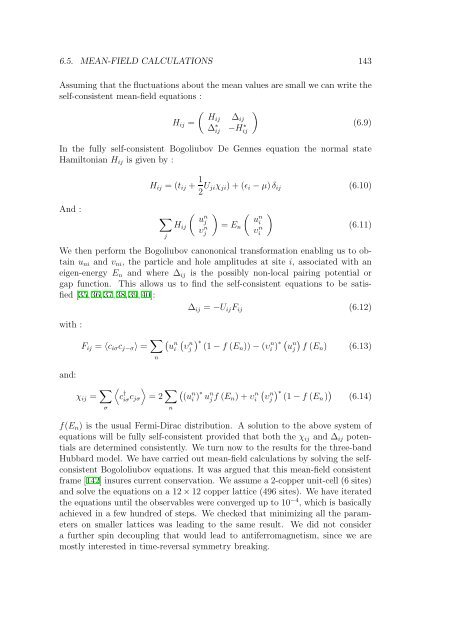pdf, 9 MiB - Infoscience - EPFL
pdf, 9 MiB - Infoscience - EPFL
pdf, 9 MiB - Infoscience - EPFL
Create successful ePaper yourself
Turn your PDF publications into a flip-book with our unique Google optimized e-Paper software.
6.5. MEAN-FIELD CALCULATIONS 143<br />
Assuming that the fluctuations about the mean values are small we can write the<br />
self-consistent mean-field equations :<br />
( )<br />
Hij ∆<br />
H ij =<br />
ij<br />
(6.9)<br />
∆ ∗ ij<br />
−H ∗ ij<br />
In the fully self-consistent Bogoliubov De Gennes equation the normal state<br />
Hamiltonian H ij is given by :<br />
And :<br />
H ij =(t ij + 1 2 U jiχ ji )+(ɛ i − µ) δ ij (6.10)<br />
∑<br />
j<br />
H ij<br />
( u<br />
n<br />
j<br />
υ n j<br />
)<br />
= E n<br />
( u<br />
n<br />
i<br />
υ n i<br />
)<br />
(6.11)<br />
We then perform the Bogoliubov canononical transformation enabling us to obtain<br />
u ni and v ni , the particle and hole amplitudes at site i, associated with an<br />
eigen-energy E n and where ∆ ij is the possibly non-local pairing potential or<br />
gap function. This allows us to find the self-consistent equations to be satisfied<br />
[35, 36, 37, 38, 39, 40]:<br />
∆ ij = −U ij F ij (6.12)<br />
with :<br />
F ij = 〈c iσ c j−σ 〉 = ∑ n<br />
(<br />
u<br />
n<br />
i<br />
(<br />
υ<br />
n<br />
j<br />
) ∗<br />
(1 − f (E n )) − (υ n i )∗ ( u n j<br />
)<br />
f (En ) (6.13)<br />
and:<br />
χ ij = ∑ σ<br />
〈 〉<br />
c † iσ c jσ =2 ∑ n<br />
(<br />
(u<br />
n<br />
i ) ∗ u n j f (E n)+υ n i<br />
(<br />
υ<br />
n<br />
j<br />
) ∗<br />
(1 − f (E n ) ) (6.14)<br />
f(E n ) is the usual Fermi-Dirac distribution. A solution to the above system of<br />
equations will be fully self-consistent provided that both the χ ij and ∆ ij potentials<br />
are determined consistently. We turn now to the results for the three-band<br />
Hubbard model. We have carried out mean-field calculations by solving the selfconsistent<br />
Bogololiubov equations. It was argued that this mean-field consistent<br />
frame [142] insures current conservation. We assume a 2-copper unit-cell (6 sites)<br />
and solve the equations on a 12 × 12 copper lattice (496 sites). We have iterated<br />
the equations until the observables were converged up to 10 −4 , which is basically<br />
achieved in a few hundred of steps. We checked that minimizing all the parameters<br />
on smaller lattices was leading to the same result. We did not consider<br />
a further spin decoupling that would lead to antiferromagnetism, since we are<br />
mostly interested in time-reversal symmetry breaking.
















